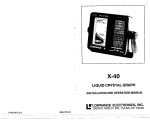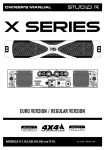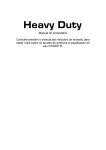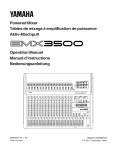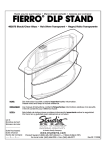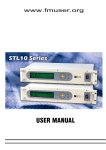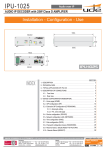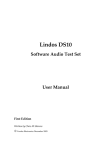Download Z.500 Owner`s Manual
Transcript
OWNER’S MANUAL 12/2006 - REV#3 / EN INTRODUCTION: Congratulations for purchasing a STUDIO R Z SERIES amplifier! Our amplifiers are designed for many years of reliable operation at fixed or movable facilities, under the strictest weather conditions. Studio R 3-year warranty (valid for Brazil. Check with your dealer for local warranty): A regular warranty usually covers the free repair of a product every time this fails during a certain initial period of its lifetime. This procedure, although free of charge, solves the problem of those components on the product which have aged prematurely on a very costly and burdensome way for the customer. Many hours are lost with the system inoperative and its transportation. Our concern with the warranty covering our products has never been that of merely repairing them promptly every time they present a fault, but also to prevent faults for a long time during their lifetimes. Studio R exclusive Burn-in: Every Studio R amplifier is in-factory tested for three 3-hour cycles at full power in a high-temperature oven. It is cooled and tested again at every interval. This exclusive process in Brazil is the only internationally proven way of finding components of a system which could deteriorate prematurely within the equipment lifetime. Our current fault rate is 2 out of every 1000 devices produced, with a 5-year time of regular use between two faults. Such kind of product really allows you to amortize your investments safely and still make profit. This is why we say that your amplifier should operate almost seamlessly, while keeping the sonic quality and performance characterizing the Studio R products. Although it is basically simple to operate, and having been designed to be endurable, the improper use of this equipment can be dangerous! FOR YOUR SAFETY, READ THE SECTIONS ON IMPORTANT PRECAUTIONS, INPUT, OUTPUT, AND POWER CONNECTIONS. 1 DANGER: THE OUTPUTS OF THIS AMPLIFIER CAN PRODUCE LETHAL VOLTAGE LEVELS. NEVER MAKE CONNECTIONS WHILE THE DEVICE IS ON. Wait for at least 1 minute after the shutoff in order to carry out modifications in your connections. WARNING: THIS EQUIPMENT IS CAPABLE OF PRODUCING HIGH SOUND PRESSURE LEVELS WHEN CONNECTED TO SPEAKERS AND SPEAKER SETS. The continued exposure to high sound pressure levels may cause the permanent loss of or a reduction in the hearing. Always work with your ears protected by appropriate attenuators. 1- IMPORTANT PRECAUTIONS: Read before operating your amplifier: 1.1 1.2 1.3 1.4 1.5 1.6 1.7 1.8 1.9 1.10 1.11 1.12 1.13 Keep this manual for future inquiries. Follow all instructions printed on the chassis for the device proper operation. Make sure the power line is compatible with your device voltage by checking on its back panel. Do not spill liquids in or on the apparatus. Do not operate the apparatus exposed to rain or with some spilled liquid. Such practice is the main reason for lethal accidents caused by electric discharges. Do not block the air inlet or outlet. Do not operate in locations liable to preventing the normal air flow. Do not use this equipment in case any wire is stripped or fractured. It is recommended to keep your amplifier frame always connected to a grounding system; do this by means of the chassis bolt on the back panel. Do not activate the inputs with a power supply greater than the required for the amplifier at maximum output. Never connect the output of a channel back to the input of another channel. Do not connect the outputs in parallel with the outputs of any other amplifier. Do not connect the outputs of this equipment with any other power supply, such as batteries or power line, either the equipment is ON or OFF. Do not connect any positive terminal to the ground. Do not remove the covers. On removing them you will be exposed to dangerous voltages. Inside the equipment there is no useful parts for the user. In case any problem occurs, call our nearest technical assistance. Technical support and information by Internet or e-mail: www.studior.com.br - [email protected] 2 2- INSTALLATION AND OPERATION: 2.1 Unpacking Open the transportation packing carefully and check for any apparent damage. Prior to leaving the plant all Studio R amplifiers are fully tested and inspected and ought to reach you in perfect conditions. Should any damage be found on them, please notify the carrier immediately. Only a forwarding agent may request the carrier to take actions concerning the damage occurred during the transportation. Make sure to keep all packing for inspection. It might be a good idea to keep the packing even when your amplifier has come in perfect conditions. Whenever it has to be transported, use the original packing or rack standard CASE, with frontal bars. 2.2 Assembling Your amplifier is designed to be assembled on a standard 19” CASE, with two units/rack (88.5 mm). The ventilation on the apparatus rear portion and the front air outlet are essential for its proper performance. This system provides enough cooling for all load rates, assuming that the rack rear portion is open and unblocked. On racks with a closed rear portion, it is vital to install additional fans on same in such a way to pressurize them, ensuring a good air source for your amplifier internal fan. 2.3 Operating precautions. Make sure that the power line AC voltage is the same selected on the amplifier. The warranty does not cover damages resulting from using the device on the wrong voltage. Also check the fuse proper use on the table of the following page. Prior to making any connection, both of input and output, make sure that the power switch is off. Even though the amplifier is fitted with overload protection as well as a Soft Start (silent activation), it is recommendable to always keep the gain controls low when turning it on. This operation will prevent any possible damages to the speakers should there be an excess signal on the inputs. Seek to acquire cables, connectors, and speaker of good quality and appropriate capacity. Check the wiring capacity table (Section 2.5) to determine the appropriate measures for different impedances and lengths of cables. Most of the systems intermittences and faults occur due to defective wires and connectors. Use quality connectors, wires, and welding technique to ensure seamless operations. Z.300 4A / 2A Z.500 5A / 3A Fuses Tables (110V / 220V): Z.700 Z.900 Z1200 6.3A / 3A 8A / 4A 15A / 8A Z1600 20A / 10A 3 2.4 Connecting the inputs The input/split connections are performed by means of two 3-pin, XLR-type and two “P10”- type connectors, located on the rear panel. The connection orientation is: BALANCED Pin 1 - Ground. Pin 2 – Positive (phase). Pin 3 – Negative (counter-phase). BALANCED I I I 1 3 2 UNBALANCED I I I 1 1 2 UNBALANCED The Z SERIES amplifiers contain balanced inputs and can be powered either by balanced lines or not, according to the figures. The fact of finding XLR-type connection cables on devices or cables does not mean your connections are correct. ALWAYS CHECK THESE DETAILS VERY CAREFULLY The figures on the following pages show the basic diagram for the connections on the rear of your amplifier in a sound system. It is important on a stereo system to connect the mixer L channel to the amp input 1, and the mixer R channel to the amplifier input 2. The same precaution should be taken for connecting the speakers. The speakers located on the right side of the stage should be connected to the right channel (OUTPUT 2), and those of the other side to the left channel (OUTPUT 1). The speaker polarity is also important. The speaker positive should be connected to the amplifier (+) positive terminal, and the speaker negative, to the amplifier (-) negative terminal. You can connect up to two 8 Ohm speakers or cabinets in parallel per channel, or only one 4 Ohm speaker or cabinet per channel. If you don’t respect these limits, you can overload your amplifier and void the warranty. 4 2.5 Connecting the outputs: The loudspeakers should be connected to the amplifier by wires which should, first, provide the minimum current capacity necessary for the work. Wire minimum gauge in mm2 (Z.500) 1mm2 1,5mm2 A wire for each speaker A wire for every two speakers Wire minimum gauge in mm2 (Z.700) 1,5mm2 2mm2 A wire for each speaker A wire for every two speakers Wire minimum gauge in mm2 (Z.900) 2mm2 2,5mm2 A wire for each speaker A wire for every two speakers In addition to the current capacity of the speaker connecting wires, it is important to know as well at what distance from the amplifier the speakers are. We may have power and damping factor losses on long-distance connections, even with the correct gauge wire. The following example can provide us with a magnitude order in this regard: An 8-ohm speaker placed at 50 meters from the amplifier and connected with a pair of 2-mm2 wires results in a damping factor of 9 only. A drop in the Damping Factor occurs on any amplifier, and it just takes the presence of a wire between same and the speaker or speaker set. On the following table see the power loss in percentage and, in parentheses, the resulting damping factor: (We can see in bold letters that the losses in long distances exceed 10%, and that the damping factor also drops to below 10. For example, with a 12% loss on a 1000-W amplifier, 120 watts are lost and the speakers receive 880 watts only.) Length of the pair of wires (in meters) 5 5 5 5 5 10 10 10 10 10 20 20 20 20 20 Gauge (mm2) 1 1,5 2,0 2,5 3 1 1,5 2,0 2,5 3 1 1,5 2,0 2,5 3 Power loss on the wires for each speaker (Damping factor) 2,2% (45) 1,5% (67) 1% (90) 0,85% (114) 0,7% (140) 4,4% (23) 3% (34) 2% (46) 1,7% (57) 1,4% (66) 8,8% (11) 6,0% (16) 4% (22) 3,4% (28) 2,8% (33) Power loss on the wires For each 2 speakers (Damping Factor). 3% (34) 2,2% (45) 1,75% (57) 1,4% (66) 6% (16) 4,4% (25) 3,5% (28) 2,8% (33) 12% (8,3) 8,8% (11) 7% (10) 6% (16) 5 Floating common: Your amplifier circuit ground is insulated from the frame. This allows various safety configurations to be made for the system grounding. SPEAKER OUTPUTS: This is where the speakers should be connected. Connect the speaker positive to the positive lug, and the negative to the speaker negative. WHEN WE SELECT THE LINE VOLTAGE ON WHICH THE AMPLIFIER WILL OPERATE, IT IS VITAL TO PLACE THE FUSE WITH THE PROPER CURRENT VALUE. SEE THE CORRECT VALUE ON THE FUSES TABLE. 2.5.1 Speaker wire terminals (BINDING POSTS) We should use wires with “banana” or “fork” connectors, the second (fork) being more reliable in the long run (the “banana” terminal gets loose in a short time). We can see that on each amplifier output channel there is a pair of lugs. The speaker positive should be connected, and the terminal with red lug is to be regarded as “hot”, which should never be connected directly to the ground. The other side of the speaker should be connected to the black lug. Never connect any wire directly between the left channel lugs and those of the right channel and vice-versa. 2.6 Connecting the power of your 4-ohm Z series: Your Studio R power cable has 3 wires with a 3-pin connector. The 4-ohm Z Series amplifiers are designed to operate on 110 V or 220 V. Under full power, with both channels set to 4 ohms (Two 8-Ohm speakers in parallel per channel), your Studio R 4-ohm Z Series amplifier can “pull” a considerable current. See on the following table the recommendable minimum gauge to use on your AC electrical installation according to the number of speakers to be used and the type of music. 6 ATTENTION: Make sure that the power line AC voltage is the same selected on the amplifier. The warranty does not cover damages resulting from using the device on the wrong voltage. Also check the fuse proper to use on page’s 4 table. Your Z Séries amplifier will protect it self when connected to the wrong voltage, by burning a safety device in its interior. In this case, your amplifier will refuse to turn-on again. You must contact our technical assistance in order to substitute the safety device and use your amplifier again. NOTE THAT THE TABLE VALUES WERE CALCULATED FOR 110 VOLTS, WITH A SETTING BETTER THAN 5% (WHICH IS A SATISFACTORY SETTING), ON AN INSTALLATION WITH NO MORE THAN 50 METERS BETWEEN THE POWER FRAME AND THE AMPLIFIER. AS TO THE 220-V LINE, WE CAN USE UP TO HALF THE GAUGE. When longer distance connections are required, such as for example 100 meters (double the distance), we should use double the gauge as well. In case of a sound system leasing company, where music is generally reproduced, we should always size the AC system for the PINK NOISE rate: PINK NOISE Z.300 0,5mm2 0,4mm2 Z.500 1mm2 0,5mm2 Z.700 1,5mm2 1mm2 Z.900 2mm2 1,5mm2 Z1200 2mm2 1,5mm2 Z1600 2,5mm2 2mm2 ROCK WITH COMPRESSION Z.300 Z.500 Z.700 Z.900 Z1200 Z1600 2 speakers p/ channel 0,5mm2 0,4mm2 1mm2 0,5mm2 1,5mm2 1mm2 1,5mm2 1mm2 2mm2 1,5mm2 2mm2 1,5mm2 Z.300 0,4mm2 0,3mm2 Z.500 1mm2 0,5mm2 Z.700 1mm2 0,6mm2 Z.900 1,5mm2 1mm2 Z1200 1,5mm2 1,5mm2 Z1600 2mm2 1,5mm2 2 speakers p/ channel 1 speaker p/ channel 1 speaker p/ channel AMBIENT MUSIC 2 speakers p/ channel 1 speaker p/ channel All of the Studio R Z Series amplifiers come with a power cable and connector. The user should consult the consumption table and, according to the intended use of his/her equipment, purchase the female connector with the appropriate capacity for the extension. 7 2.7 Stereo Operation: For stereo operation, place an audio signal on the channel “1” input with an amplitude consistent with the amplifier sensitivity (selectable according to the SDS table) in order to produce a signal output on channel “1” parallel lug, while a signal in “2” will produce a signal output on the parallel connector in “2”. SDS table (gain/sensitivity adjust): Sensitivity Euro Version Regular Version DS (centered gain - “DS” point) 26dB / 20x 1.55V Maximum (gain at 10 position) 32dB / 40x 0.775V IMPORTANT: The 1.55V level (in regular versions) is equal to -6dBm or -6 dBU. You must always use this level, instead of 0.775V, when using digital processors. In other cases, adjust according to your system sensitivity. Both channels operate on a completely independent way, with their respective input attenuators controlling the total levels. In order to distribute the signals to other amplifiers we must use connectors parallel to the input connectors: “P10” in case of input via “XLR”, and “XLR” in case of inputs via “P10”. Inputs: XLR balanced or P10 balanced parallel. “1” is the left channel, and “2” the right one. Mode selector STEREO or PARALLEL. VOL/GAIN: Input signal attenuators. The controls operate separately even on the parallel operation. “DS” position (center) indicates 1,55V sensitivity. “10” position (max) indicates 0,775V sensitivity. 8 2.8 Parallel operation: Both channels, on the parallel mode, can be fed by a single input signal source without the need for any bridge. The signal applied on the “XLR” or “P10” of channel 1 will activate both sides with the signal in phase. The output connections are made in the same way as the stereo mode via the channel and black lugs. Both input attenuators remain active, allowing for different levels for the speakers of each channel. The power specifications continue the same as on the stereo operating mode. Attention: With the input switch on the parallel mode we can feed the amplifier inputs with distinct signals, as they will be short-circuited. 2.9 Input signal attenuators (VOL/GAIN). The rotary controls located on the back panel of your Studio R, one for each channel, allow the input sensitivity to be individually set with a reasonable resolution. On the scale recorded on the panel from 0 to 10, the amplifier input signal level on the stereo and parallel modes can be individually modified. When fully turned on the clockwise direction, they will allow a signal on the input sensitivity rate of 0,775V (or 32dB/40x - Euro Version only) to provide a maximum power on a 4-ohm load. When at the center click point (DS), sensitivity rate will be 1,55V (or 26dB/20x - Euro Version only). IMPORTANT: As the attenuators are independent, the channels can be set with different signal levels. This occurs when each one of the channels are being used for different environments or on different frequency ranges such as bass and treble. (The speakers always withstand more power than the drivers. Be careful with the settings!). VERY IMPORTANT THE INPUT SENSITIVITY CONTROLS OF THE Z SERIES AMPLIFIERS ARE NOT POWER SETTINGS (A HEAVY-DUTY LINE EXCLUSIVENESS!). The regular setting of these will never be able to protect delicate speakers with power lower than that the amplifier is able to provide. In these instances, an appropriate external limiter should be used. 9 2.9.1 Power Switch: Studio R 4-ohm Z-series amplifiers are fitted with an on/off switch located on the front panel. In the regular use, when the switch is pointing upward, this turns the amplifier on and two green LEDs will light up on the panel. ATTENTION Prior to turning your amplifier on make sure that the power line voltage is same as selected on the apparatus. This is statistically the only way of damaging a Studio R. In addition, it is regarded as a misuse and is not covered by the warranty. Power indicator: Lights up when the power switch is turned on. Power switch lever: Turns the amplifier on or off. Signal indicators on the amplifier output. Signal processing indicators to prevent distortions: Flashing slightly when the amplifier is under full power is normal. 3 – INDICATORS: The Studio R 4-ohm Z-Series amplifiers are equipped with LED-type light indicators, individual for each channel, which report the user on the operating condition. If the power is on or off, the green LEDs “CHANNEL...ON” will light up. If a signal is present on the output, two green LEDs “SIGNAL” will flash according to the signal on each of the channels. When the maximum output power is reached, the blue LEDs (Signal processing) will light up according to the intensity of the limiter acting and activation. See the following: 3.1 Signal processing indicators: When the processing blue LED lights up, this indicates that the input signal limitation has started. When the red LED flashes occasionally, a tolerable soft limiting will be occurring. In case the input signal exceeds too much the input nominal level, the limiter will start operating so as to avoid any distortions greater than 2%. 10 4 - PROTECTION FEATURES (EPS) The Studio R Z Series amplifiers incorporate several protection systems, both for the amplifier and the speakers. We seek to produce your amplifier on a “fail-safe” way, impenetrable by shortcircuits, open circuits, overloads, unequal loads, and damages due to overheating. Under conditions where protection mechanisms are enabled, the operation stops until the problem is cleared. 4.1 Impedance sensor: All Studio R amplifiers are fitted with a system to assess the type of load on its output. On an excess load, this limits the maximum output current without causing any severe distortions. 4.2 Thermal Protection: Studio R amplifier dissipator is one of the most effective available in the market. It provides double the required thermal capacity and its fans will keep the amplifier operating within the desired temperature limits under normal conditions. Should the temperature (or heat dissipator) reach 95º C due to an improper air supply, air input or output blocking, or else due to the breakdown of its own fan, a thermal sensor will be enabled in such a way to protect each channel individually until the temperature returns to an acceptable level. 4.3 Short circuit: If a short-circuit is applied to an output, the limiting and thermal circuits will protect the amplifier. 4.4 Fuses: Assuming that an accident occurs in which the amplifier output electronics are severely damaged, your amplifier still relies on an internal fuse which will not allow the fault to propagate to other parts of the system. Soft Start. When you turn on a Studio R Z Series amplifier, its circuits are powered on a symmetrical and totally silent way. Soft Clip. With the Z Series limiter, you will always be able to use your PA at full power without any distortion. Even when the line voltage is quite altered, your Studio R will know how to dispense the power in such a way to avoid any audible distortion. 11 - VARIABLE-SPEED FANS: Three stages variable-speed fans automatically maintain internal temperatures within a safe operating range, with minimum noise. 5 - SPEAKER PROTECTION METHODS: All speakers present physical limits. The most critical ones are the thermal and mechanical limits, which should be observed so as to avoid its operation stoppage. Studio R amplifiers contain energy enough to damage most of the speakers existing in the market without much effort, if misused. Make sure that the frequency range used is appropriate for the speaker, particularly the subsonic frequencies which are not reproduced by the speaker. Always set your crossover to the ideal frequencies. Check the speaker manual for determining the maximum “X” and “f3”. ) TIP: Ask for the service leaflet to the speaker manufacturer in order for your own technician to master the subject. Never power DRIVERS and TWEETERS without an appropriate series capacitor! For drivers, an optimum value is 47 micro Faraday. For most of the tweeters, a 5.6uF capacitor is appropriate. 6 – OPERATION ON AMBIENT SOUND: All 4-ohm Z Series amplifiers can operate on the constant voltage line configuration for ambient sound installations. This type of installation is quite used successfully in bars, night clubs, churches, etc. For example, The Z.500 operates as a 30Volts line amplifier. In this way, you can connect up to five 15 watts speakers using Studio R transformers model AML 15/30. Consult for other models. 12 7 – MAINTENANCE: Your Studio R amplifier does not require much maintenance, which is restricted to its outer cleaning. Do not use any solvent, but only a cloth wet with water and soap. During its lifetime the amplifier will not require any internal setting. NEVER BLOW COMPRESSED AIR INTO THE AMPLIFIER ELECTRONICS OR ANY OTHER SIMILAR EQUIPMENT. 8 - USER RESPONSIBILITY: YOUR AMPLIFIER IS QUITE POWERFUL AND CAN BE POTENTIALLY DANGEROUS! STUDIO R IS NOT RESPONSIBLE FOR ANY DAMAGE CAUSED TO HUMANS OR SPEAKERS. FOLLOW CAREFULLY THE INSTRUCTIONS SET FORTH IN THE MANUAL AND THE RELEVANT STANDARDS RELATED TO YOUR INDUSTRY. 9 – WARRANTY:: Studio R provides the purchaser of any Z Series amplifier with a warranty against defects on the components and assembly for a 3-year*** time as of the purchasing date (***Valid for Brazil. Please check with your dealer about local warraty). IMPORTANT: Studio R reserves the right to introduce changes or improvements into the design and manufacturing of its amplifiers, without undertaking any obligation to do so in the previously manufactured products. Do not forget to send us the registration sheet already filled out to make it easier for serving you and sending information and future novelties. Such registration can also be made on our site: www.studior.com.br In the event you are unable to install or to take the best profit you expect from your equipment, get in touch with our International Technical Support: [email protected] STUDIO R Eletronica LTDA Rua Lucrecia Maciel, 95 – Vl Guarani. CEP 04314-130 Sao Paulo, SP – Brazil +55 (011) 5015-3600. Visit our website: http://www.studior.com.br E-mail: [email protected] 13 General Specifications: CLASSIFICATION HARMONIC DISTORTION 1KHz @ 1/2 of rated power HARMONIC DISTORTION 20Hz-20KHz@ rated power FREQUENCY RESPONSE DAMPING FACTOR NOISE SENSITIVITY INPUT IMPEDANCE CONTROLS INDICATORS CONNECTORS COOLING PROTECTION 120V 60 Hz power line AB Class 0.05%, 4 ohms 0.02%, 8 ohms lower than or equal to 0.2%. 20Hz a 20khz, +/- 0,7dB. Greater than 2000 at 8 ohms @ 40Hz 105 dBA relative to the maximum power. 775mVRMS for the rated power or 1,55V (selectable). 10 Kilohms balanced Front: power switch. Rear: parallel/stereo switch, 110/220V selector, and rotary settings for the input signal attenuation. Power - 2 green LEDs Signal - 2 green LEDs Processing - 2 blue LEDs Line inputs and outputs: 2 XLR female connectors and 2 P10 female connectors, balanced (pin 1 and 3 ground, 2” +”). Chassis and floating common connecting bar. Speakers: 2 pairs of 1/4’ lugs (one pair for each channel). Aluminum duct with forced ventilation. Soft Clip, Soft Start, short-circuited or open output, reactive or mismatched loads, and over the input signal. Independent thermal sensors for each channel. Silent on/off, output power limiter with reference to 2% of DHT. Linear complementary, Soft Clip. 110 or 220V AC (selectable) 1.65 times the output power used. 88,5MM x 483MM x 320mm LOAD PROTECTION OUTPUT CIRCUIT POWER PRECISE CONSUMPTION DIMENSONS (height x width x depth) WEIGHT/RATED POWER and Z.500 – 5kg/ 500W, 110V; 5A / 220V; 3A MAXIMUM CONSUMPTION Z.700 – 5kg/ 700W, 110V; 6,3A / 220V; 3A Z.900 – 5kg/ 700W, 110V; 8A / 220V; 4A SINUSOIDAL POWER TABLE: Valid for 120V/60Hz line (standard IEC-60268-3). For line voltage variations in the amount of 10%, the powers can vary up to + or – 22%. Model Z.500 Z.700 Z.900 Z1200 Z1600 4 ohms - 2 channel 500 watts RMS 700 watts RMS 900 watts RMS 1200 watts RMS 1600 watts RMS 8 ohms - 2 channel 340 watts RMS 430 watts RMS 500 watts RMS 720 watts RMS 1000 wattsRMS 4 ohms - 1 channel 300 watts RMS 375 watts RMS 480 watts RMS 660 watts RMS 880 watts RMS 8 ohms - 1 channel 190 watts RMS 230 watts RMS 270 watts RMS 400 watts RMS 540 watts RMS ATTENTION: A 4-ohm Z Series amplifier should power no more than 2 speakers per channel. This is this condition where it will provide its maximum stereo power. 14















